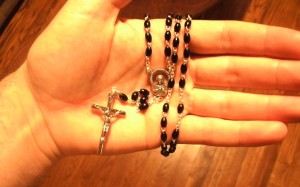Jason, my Mentor this month, once explained the concept of the Holy Trinity (God the Father, Son, and Holy Spirit) by alluding to the notion that we humans are made in God’s image. He described how we ourselves are mind (the creative, like the Father), body (the expressed and manifested self, like Christ), and spirit (the pure self, action, and love, like the Holy Spirit).
Just as God’s words brought forth reality out of nothing (ex nihilo), so do our human thoughts produce buildings, actions, and even nations. We, like God, can express ourselves in the environment around us. This is the foundation of art and the very reason art and architecture (religious in this case) speaks to us so profoundly. It’s why we can gaze for hours at a flower or mountain. It’s why we can see a cross and fall to our knees.
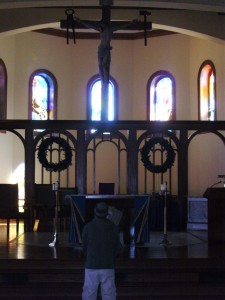
A few days ago, my Mentor decided to take me on yet another road trip. This time, he wanted to show me the various art and architecture of Catholic churches in our area. The image above is from Saint Brendan the Navigator Roman Catholic Churchin Shallote, North Carolina. This is a new church and so much of the work here displays a more contemporary style.
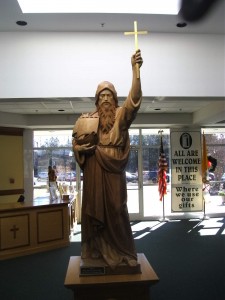
One of the best features of St. Brendan’s was the display of various cross styles. Each cross is given a brief history. We will focus more in depth on the cross later.
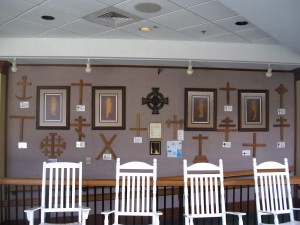
Just behind the wall of crosses is another wonderful feature of the Church. In most cases (virtually all), Catholic churches will do whatever they can to aid the poor or those in need. Just as I was gazing at this wall, folks in need from the community were walking through and gathering clothing and a hot meal. The church doesn’t ask if you’re Catholic and you don’t receive a sermon before you eat. The church only asks what you need.
“Preach the gospel at all times. When necessary, use words.” –attributed to St. Francis of Assisi
The church shown below was the first we visited. A small church by comparison to the others, it looses none of its potency. We came to the church during a renovation. As the Father (pastor) of the church explained to us during his greeting, “The poor do not build new churches. We renovate.”
Welcome to the Sacred Heart of Jesus Catholic Church in Whiteville, North Carolina.
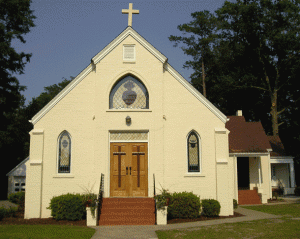
The Sacred Heart refers to the unconditional and redemptive love of Jesus and his passion. It is usually displayed in art in Christ’s hands or chest where it bears a holy fire, crown of thorns, and a pierced wound.
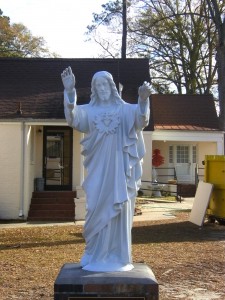
As a Protestant back in high school, I never placed much stock in the crucifix. I always wore the “empty” cross because it symbolized the risen Christ. This month I’ve had to face the horror and bloody reality of the crucifix.
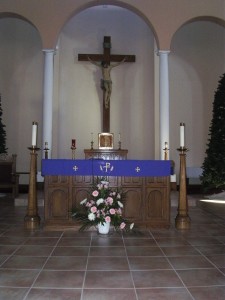
Here is the crucifix above the altar at Our Lady Star of the Sea Catholic Church in North Myrtle Beach, South Carolina. The crucifix is huge and life-like. It could be you up there, or me, and as you gaze at the image and meditate on its meaning…you realize as a Christian that that’s exactly the point.
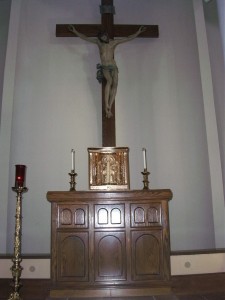
You have to see this crucifix to get an idea of the agony Christ went through. My Mentor told me as I looked up at the nails in his feet, “This is what sin looks like, Andrew. It pins you down, it deforms your body and rots your soul. When crucified, you don’t usually die from your wounds, but from suffocation. Sin will suffocate you.”
And the whole point of the cross and the centrality of the Christian faith. Christ absorbed the sin of all time and had it nailed with himself to the cross, thus pinning it down so that it could harm us no longer.
“God made him [Jesus] who had no sin to be sin for us, so that in him we might become the righteousness of God.” –2 Corinthians 5: 20
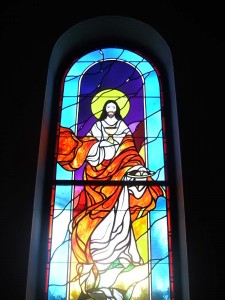
In each of the five churches we visited, the gospel came to life through art. I’ve hinted at this before regarding my local Catholic church and the panels on the wall showing the Stations of the Cross (the course Jesus took during his Passion). Indeed, my Mentor was right. Your pastor could preach horribly. The music could be lame and off key, but for the ones in the pews who really know what’s going on in the art and in the Eucharist…none of that matters. They aren’t there for the preaching, they are there for the word of God being read out of the Scriptures and the celebration of Christ present in the Eucharist.
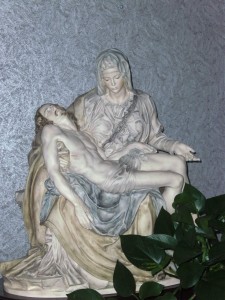
We should not be afraid of art, of our passionate attempt to express what we feel and love. Art is a struggle and a release that even when brought to fruition is never enough. No matter how realistic these portraits or statues are they will never show the whole picture, but it gets us closer.
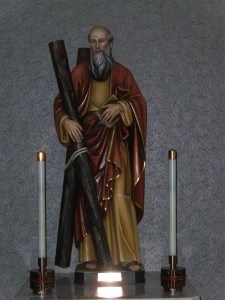
I can’t show you all 70 photos I took from our latest road trip into Catholicism, but I wish I could. This blog is my way of trying to show you each of these faiths through my eyes, through my mind, as I discover and re-discover them for the first time. In this way, this blog and Project Conversion itself is my art. We are painting an image here and trying to capture the intimate details of a world vision of compassion, humanity, and learning. Will I ever conquer and express the exact words…probably not, but it sure is fun and enlightening to try.
In the midst of all of this, remember, that from the Christian standpoint, regardless of how you feel about art in faith, was Jesus not the masterpiece of the Father? Was Jesus not God’s manifested expression of love and compassion? Chew on that for a while…
What does art mean to you in your spiritual life? Is there are particular piece–regardless of religion–that centers you, brings you peace? Is there even a place for art in the religious life or is it all idolatry? Is art an effective vehicle for our relationship with the divine?
